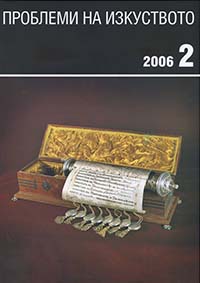Ппиложното изкуство в структурите на ежедневието. Етюди от детството му
Applied Art in the Structure of Everyday Life. Sketches from its Childhood
Author(s): Violeta VasilchinaSubject(s): Theatre, Dance, Performing Arts
Published by: Институт за изследване на изкуствата, Българска академия на науките
Summary/Abstract: This text reflects on a few aspects of the formation of applied art in Bulgaria in the beginning of the 20th century. Viewed as a transplanted and adopted European artistic practice and in the light of continual influence from European cultural and industrial centers, applied art reveals its nature in its relation to towns and the forms of urban life, the necessities of the elite and of the state. Its critical examination in the amplitude between the "desired" and "achieved" europeisation, turns our attention to the available means of modernization and the inevitable appearance of hybrid forms, which enrich the scope and content of some European artistic tendencies in Bulgaria. The history of artist-created applied art in Bulgaria starts shortly before the end of the 19th century, when Boris Shatz reveals in an exhibition the wall-hanged embossed porcelain plate "Moses' Mother Leaves Her Son to the Mercy of the Waves of the Nile" (1895). A year later the State School of Painting opens, a few years after that — the "applied" workshops, and it would be about ten years before the next appearances in exhibitions. It takes some more years before the main genres are established. Special attention is paid to the relationship between decorative and applied arts — a relationship that is first discussed as a heritage of European 18th century "classicism", and then again in the context of later neo-classical influences. This brings up the issue of the late secondary adoption of neoclassical aesthetics in the end of the 19th and the beginning of the 20th century, which is revealed in Bulgarian public and residential architecture (as well as object shapes and interior design) even as late as the end of the 1930s. The article also focuses on the formation of the new image of the capital during the first decade of the century. The importance of the imposing "national style" buildings is stressed. An attempt is made to pose the uniqueness of Bulgarian works as a blend of nationalist/romantic and secessionist characteristics. In the context of this setup, the article looks into the appearance of similar characteristics in other genres: the proper applied arts (furniture and carving, ceramics), applied illustration (posters, advertisement, book design) and space layout (shows and exhibitions). This "patchwork" analytical approach proves useful in putting early 20th century applied art in perspective with relation to national artistic development and in evaluating it beyond the biased views about its aesthetic inferiority to the fine arts.
Journal: Проблеми на изкуството
- Issue Year: 2006
- Issue No: 2
- Page Range: 3-11
- Page Count: 9
- Language: Bulgarian
- Content File-PDF

